A true pre-war Martin rides again with a neck reset, crack repair, and bridge reglue!
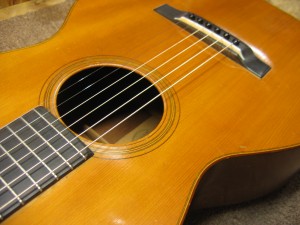
The owner of this 1930 Martin 518 saw work we performed on another Martin and entrusted us to repair a lengthy side crack, separated bridge, and to reset the neck angle. This is work we frequently perform on older Martins, but we thought you might like to see it done on a real pre-war model.
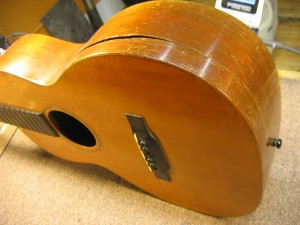
For more than a century, guitarists have recognized something special about Martin guitars. Great feel, great sound, great looks. But we repairmen have grown to love them for a different reason. For most of that time period, Martin has built guitars with certain qualities that make extensive repairs possible even on very old instruments. Until they recently began bolting necks into bodies, all of their parts have been held together by precise fitting joints and small amounts of glue. A little bit of heat or steam in just the right place allows us to loosen that glue just enough to correct even very small changes. They suggest that even 70 years ago these craftsmen understood that some day their work would need to be taken apart and put back together. Thanks guys!
We began this repair by addressing the most obvious problem: a split in the lower side that stretched across most of the lower bout. We glued and clamped it together using spool clamps and traditional hot hide glue. For a guitar like this with its original finish intact, we’ll skip the touch-up and just try to smooth and clean the crack area so it doesn’t stick out like a sore thumb.
Next we move on to the neck. Over time, the pull of steel strings has pulled the neck into a steeper angle. As a result, the string action gets higher and higher, requiring the bone saddle to be lowered nearly to the top of the ebony bridge. Since we can’t go any lower with this saddle, we’ll remove the neck completely and reset the dovetail joint so we have a healthier angle and more comfortable playing action. At the same time, we noticed that the back of the bridge was beginning to pull off the top, so with the owners permission, we removed it and cleaned the gluing area. We’ll glue it back down later.
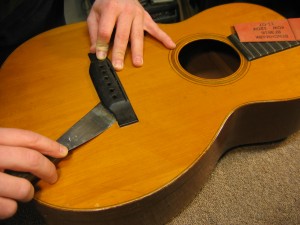
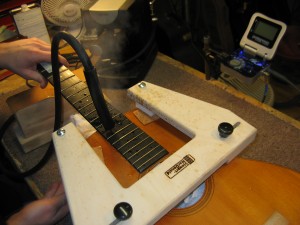
The neck reset begins with removing the thirteenth fret and drilling a tiny hole in the fret slot where we’ll inject steam to loosen the glue that holds the neck joint together. Why the thirteenth fret? Because That’s where you find the end of the dovetail’s tenon on every guitar. In the picture below you can see the two drill holes right at the edge of the tenon.
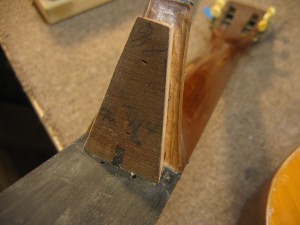
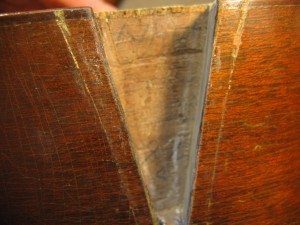
Once the neck is off, Dan removes the remaining old glue while it’s still soft. Then he changes the neck angle by removing small amounts of material from the neck heel. How small? He pulls strips of sandpaper against the neck heel, keeping count of how many pulls per side. Once the angle is right, the neck goes back on. (You’ll notice the bridge is now back in place too.)
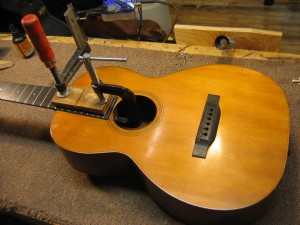
The next day, when the new glue is set, he planes the fretboard level and replaces the frets… usually. But in this case, the fret wire is actually steel bars, not modern nickel fret wire. Bar frets are not only part of the guitar’s history and character, they’re also no longer made. So to make the original frets taller, he raises them by filling the fretboard slots with glue and ebony dust. Then he hammers them back into place, levels the tops and dresses the fretboard.
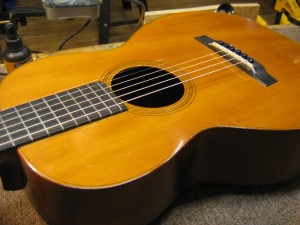
The final steps are a new vintage style bone saddle, handmade here for this guitar alone, then a fresh set of lightweight strings – to put minimal stress on this old instrument, and our Works setup.
This pre-WWII Martin has survived nearly seventy years and with this work, should be playable for many more. It sounds incredible.

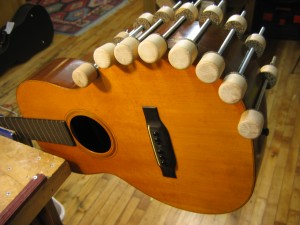
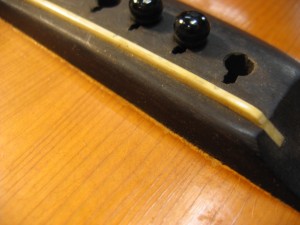
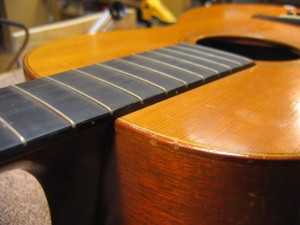
First question: did you make the bar frets in the Martin 518 repair taller just to make them easier to play cleanly. I have this problem on my 1890s 1-21. What would it cost to have these frets raised up. Gruhn did the refret on it.
Second question: I have a 1927 Martin O-18 that needs (1) neckset (2) clean up original bar frets and reseat 2 of them that have shifted sideways – and make the frets taller? (3) new pirimid bridge, rebore pin holes or new bridgeplate (4) 3″ back crack. Could you give me an estimate for these repairs and I’m really curious about having bar frets made taller. – John Evans
Good questions John. We did raise the frets to try to get cleaner notes. In general, a neck reset almost always requires a refret as well. In this case, we didn’t want to use modern fret wire. We did actually just find a source for bar fret wire that will need to be cut and shaped so conceivably we could refret your guitar using new bar frets. I’ll email you with some additional estimates for the work you’ve requested. We can certainly deliver on all of those issues.
Nice work on the 5-18. FYI–you said in the piece that bar fret wire is no longer being made. It’s true that Martin doesn’t sell it anymore, but luthier T.J. Thompson of West Concord, MA now offers bar fret stock for sale in different widths. He found a manufacturer who could replicate Martin’s original wire.
Feel free to drop me an email if you want his contact info.
David
David,
We did actually contact Martin and found that they are willing to sell some bar stock. Though their response was along the lines of ‘Um, sure we could send you some, but why would you want to use that stuff?’ Funny. Thanks for the additional source info. I’ll look him up or let you know if we can’t find him.
There are other instruments which still use bar frets, one of which is the alpine concert zither. In fact because it has a shorter scale length than a guitar, it can have multiple thicknesses of bar frets progressing from the lower note end to the higher note end of the scale where the frets are much closer together. The concert zither has a following in the US but is still largely European, mainly Germany and Austria. Just lookup concert zither on wikipedia.com.
PS: on the concert zither note. It’s bar frets stand as much as 3mm above the fingerboard, as it is played horizontially with fingering from above. The strings are not to touch the fingerboard, so enough space needs to be there to avoid string contact with the fingerboard. This allows tremolo, bends and slurs, etc. So there is a big use for bar frets.